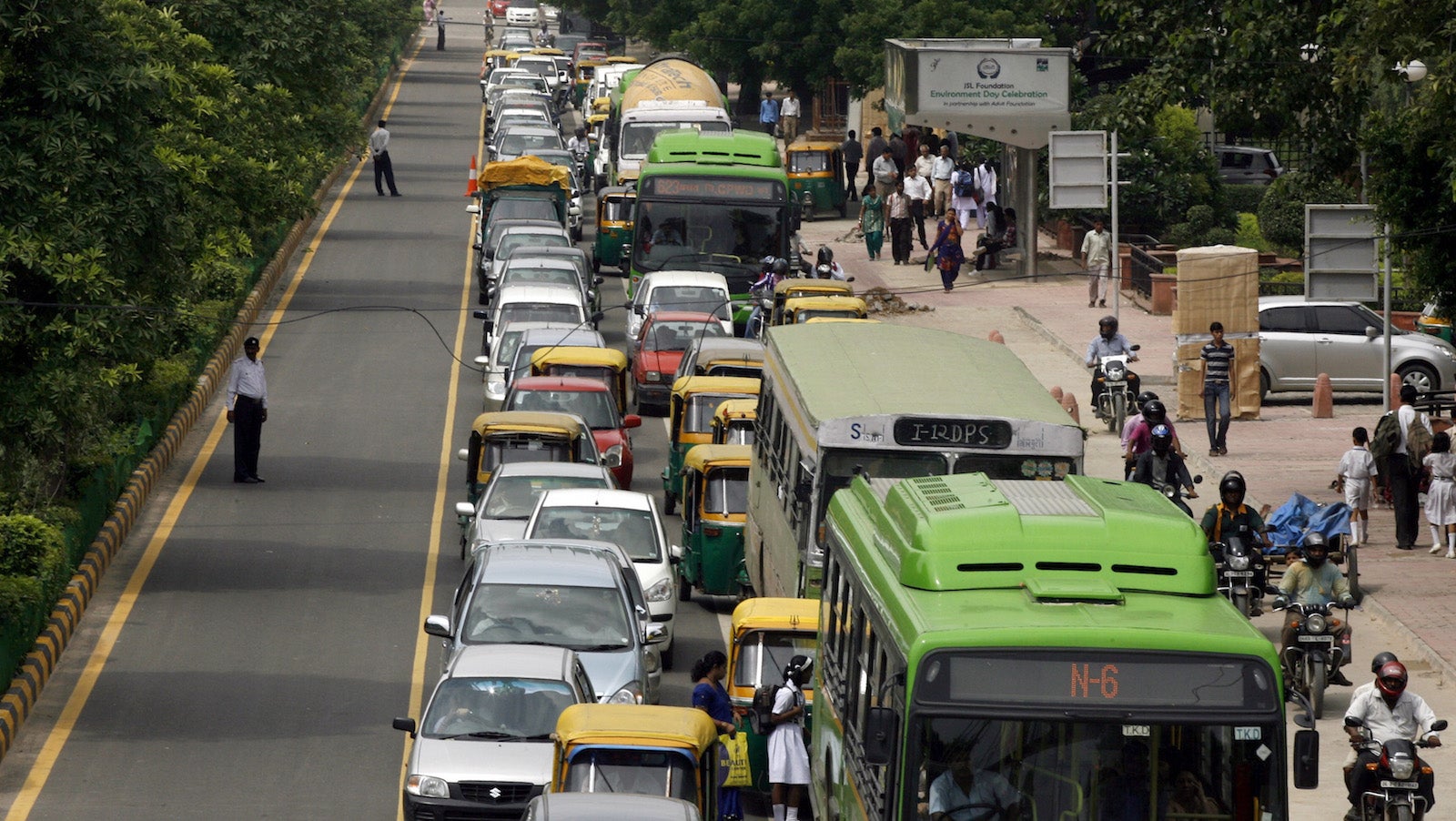After years of commuter agony and crores of rupees, Delhi’s infamous BRTS is being scrapped
India’s capital city is finally getting rid of the much-loathed Bus Rapid Transit corridor.


India’s capital city is finally getting rid of the much-loathed Bus Rapid Transit corridor.
The Delhi Bus Rapid Transit System (BRTS) was introduced in 2008 in South Delhi. It started out as a way to make the daily commute smoother in the city, which had more than 7.35 million vehicles in 2012. But ironically, the system only served to cause traffic jams, angering commuters for years.
The BRTS divided each side of the road into four lanes, each dedicated to buses, scooters and cars, cyclists, and pedestrians. But a lack of lane discipline, improper planning, and faulty traffic signals caused heavy congestion along the roads, making commutes much longer.
“From the implementation to the location of the bus stops, every aspect is wrong,” Enrique Penalosa, a former mayor of Bogota, Colombia, who pioneered the BRTS in his city, told the Times of India newspaper in 2014.
Now, the new government under the Aam Aadmi Party, which came to power earlier this year, has finally decided to scrap the system and open up Delhi’s roads.
Here is a timeline of the short-lived BRTS in Delhi.
2004: The Delhi government appoints RITES (formerly Rail India Technical and Economic Service) and the Indian Institute of Technology Delhi to design and implement the first BRT corridor on a 14.5 kilometre stretch from Ambedkar Nagar to Delhi gate. The idea is to set up a system that gives the right of way to buses and safeguards cyclists and pedestrians.
April 2006: The Delhi Integrated Multi-Modal Transit System (DIMTS), a special purpose vehicle created by a joint venture between the Delhi government and infrastructure financing firm IDFC, is set to operate on the BRTS. In total, the government plans to build 26 BRT corridors in Delhi, covering a total length of 310 kilometre by the year 2020.
October 2006: Construction work on the BRTS starts. The project would eventually go on to cost Rs150 crore. While the bus lane is 3.5 metres wide, the second lane for scooters and cars is seven metres wide. Cyclists and pedestrians have a two metre lane each.
May 2008: Trial run of the BRTS starts on a 5.6 kilometre stretch between Ambedkar Nagar and Moolchand. The Delhi government introduces 20 new low-floor buses. Within a few months, residents and commuters raise concerns about the heavy traffic jams on the BRTS corridor.
March 2011: The transport department identifies 14 more such corridors for the BRTS. The project is to be completed at a cost of Rs4000 crore.
March 2012: The Delhi government asks the Central Road Research Institute (CRRI) to study the effectiveness of the BRTS. The decision comes after the Delhi High court asked the state government to study the traffic patterns along the BRTS following a a public interest litigation filed by a Delhi-based NGO, Nyaya Bhoomi. The court allows a free run for other vehicles on the BRTS during the period of study.
July 2012: According to the CRRI report, Delhi’s car owners lose over Rs2.48 crore annually due to the fuel loss caused by prolonged queues of vehicles on the BRTS corridor.
October 2012: The Delhi high court dismisses a petition by Nyaya Bhoomi to scrap the BRTS. ”A developed country is not one where the poor own cars but one where the rich use public transport,” the court said. ”Even if we were to accept the argument that as of today…some inconvenience is being caused across the board to everybody, we have to keep in mind that planning is always long-term and the fruits of the labour invested today may not be available in the immediate future.”
November 2013: Delhi’s then government under Sheila Dikshit, who had consistently defended the project, finally yields to pressure before the city went in for elections. “We could not make the project successful. We already suspended all other BRTS projects. The concept did not meet the expectation. So we will have to scrap it,” Dixit said ahead of the elections.
December 2014: The Delhi government hands over the maintenance of the project from DIMTS to the Public Works Department. This comes a day after the Delhi police chief wrote to the government seeking the scrapping of the corridor. According to reports, the Delhi government paid DIMTS Rs6-7 crore each year for maintenance.
July 2015: The AAP government finally scraps the project. “This was a public demand. There have been several accidents and traffic has become haphazard (along the BRTS corridor). Taking all this into account, the Delhi government has decided to scrap the BRTS corridor,” Manish Sisodia, Delhi’s deputy chief minister said.